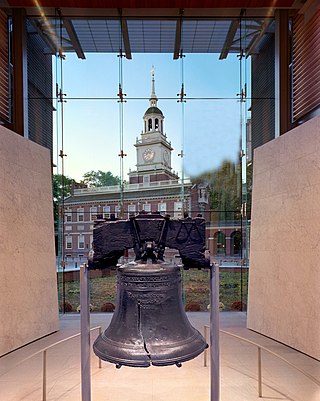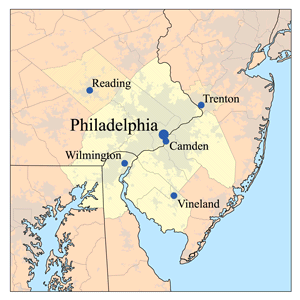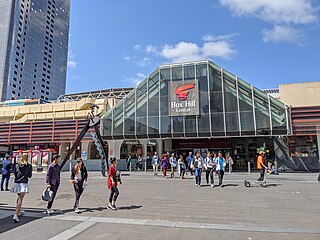Related Research Articles

Pennsylvania, officially the Commonwealth of Pennsylvania, is a state spanning the Mid-Atlantic, Northeastern, Appalachian, and Great Lakes regions of the United States. Pennsylvania borders Delaware to its southeast, Maryland to its south, West Virginia to its southwest, Ohio to its west, Lake Erie and the Canadian province of Ontario to its northwest, New York state to its north, and the Delaware River and New Jersey to its east.

Philadelphia, often called Philly, is the largest city in the Commonwealth of Pennsylvania and the second-largest city in both the Northeast megalopolis and Mid-Atlantic regions after New York City. It is one of the most historically significant cities in the United States and served as the nation's capital until 1800. Philadelphia is the nation's sixth-largest city with a population of 1,603,797 as of the 2020 census. Since 1854, the city has been coextensive with Philadelphia County, the most populous county in Pennsylvania and the urban core of the Delaware Valley, the nation's seventh-largest and one of the world's largest metropolitan regions with 6.245 million residents. Philadelphia is known for its extensive contributions to American history, especially the American Revolution, and for its contemporary influence in business and industry, culture, sports, and music.

Philadelphia County is a county in the Commonwealth of Pennsylvania. It is the most populous county in Pennsylvania and the 24th most populous county in the nation. As of the 2020 census, Philadelphia County had a population of 1,603,797. Its county seat is Philadelphia, the nation's sixth-largest city.

Chester County, colloquially known as Chesco, is a county in the Commonwealth of Pennsylvania. It is located in the Delaware Valley region, located in the southeastern part of the state. As of the 2020 census, the population was 534,413, increasing by 7.1% from 498,886 in 2010. The county seat and most populated municipality is West Chester. Chester County was one of the three original Pennsylvania counties created by William Penn in 1682. It was named for Chester, England.

This article is about the demographic history of the United States.

Radnor Township, often called simply Radnor, is a first class township with home rule status in Delaware County, Pennsylvania, United States. As of the 2019 United States census estimate, the township population is 31,875. Radnor Township is the largest municipality in Delaware County by land area and the fourth-largest by population, following Upper Darby Township, Haverford Township, and Chester.

The city of Philadelphia was founded in 1682 by William Penn in the English Crown Province of Pennsylvania between the Delaware and Schuylkill rivers. Before then, the area was inhabited by the Lenape people. Philadelphia quickly grew into an important colonial city and during the American Revolution was the site of the First and Second Continental Congresses. After the Revolution the city was chosen to be the temporary capital of the United States. At the beginning of the 19th century, the federal and state governments left Philadelphia, but the city remained the cultural and financial center of the country. Philadelphia became one of the first U.S. industrial centers and the city contained a variety of industries, the largest being textiles.

The Delaware Valley, sometimes referred to as Greater Philadelphia or the Philadelphia metropolitan area, is a metropolitan region in the Northeast on the East Coast of the United States that centers on Philadelphia and spans four U.S. states: southeastern Pennsylvania, southern New Jersey, northern Delaware, and the northern Eastern Shore of Maryland. According to the 2020 census, the core metropolitan statistical area of the Delaware Valley had a total population of 6.288 million, making it the nation's seventh largest and world's 35th largest metropolitan area, while the combined statistical area of the Delaware Valley contains a total population of 7.366 million.

The history of Pennsylvania stems back thousands of years when the first indigenous peoples occupied the area of what is now Pennsylvania. In 1681, Pennsylvania became an English colony when William Penn received a royal deed from King Charles II of England. Although European activity in the region precedes that date. The area was home to the Lenape, Susquehannocks, Iroquois, Erie, Shawnee, Arandiqiouia, and other American Indian tribes. Most of these tribes were driven off or reduced to remnants as a result of diseases, such as smallpox.

Wayne is an unincorporated community centered in Delaware County, Pennsylvania, United States, on the Main Line, a series of highly affluent Philadelphia suburbs located along the railroad tracks of the Pennsylvania Railroad and one of the wealthiest areas in the nation. While the center of Wayne is in Radnor Township, Wayne extends into both Tredyffrin Township in Chester County and Upper Merion Township in Montgomery County. The center of Wayne was designated the Downtown Wayne Historic District in 2012. Considering the large area served by the Wayne post office, the community may extend slightly into Easttown Township, Chester County, as well.

At the 2010 census, there were 1,526,006 people, 590,071 households, and 352,272 families residing in the consolidated city-county of Philadelphia, Pennsylvania. The population density was 4,337.3/km2 (11,233.6/mi2). There were 661,958 housing units at an average density of 1,891.9/km2 (4,900.1/mi2).

The culture of Philadelphia goes back to 1682 when Philadelphia was founded by William Penn. Originally inhabited by the Lenape, Philadelphia was envisioned as a place where people could live without fear of persecution because of their religion. As a result, many Quakers, Mennonites, and others came to find refuge within the city. As Philadelphia grew into a major political and economic center of the United States, many different groups of religions and ethnicities flocked to the city. 19th and 20th century immigration and migration led to large concentrations of Irish, Italians, Germans, Asians, Puerto Ricans and African Americans. Philadelphia continues to be a major destination for immigrants, with large Chinese, Vietnamese, Korean, East African, Middle Eastern, Indian and Mexican immigrant populations, among others.

An ethnoburb is a suburban residential and business area with a notable cluster of a particular ethnic minority population. Although the group may not constitute the majority within the region, it is a significant amount of the population. That can greatly influence the social geography within the area because of cultural and religious traditional values exhibited. Ethnoburbs allow for ethnic minority groups to maintain their individual identity, but that may also restrict their ability to fully assimilate into mainstream culture and society.

Black flight is a term applied to the migration of African Americans from predominantly black or mixed inner-city areas in the United States to suburbs and newly constructed homes on the outer edges of cities. While more attention has been paid to this since the 1990s, the movement of black people to the suburbs has been underway for some time, with nine million people having migrated from 1960 to 2000. Their goals have been similar to those of the white middle class, whose out-migration was called white flight: newer housing, better schools for their children, and attractive environments. From 1990 to 2000, the percentage of African Americans who lived in the suburbs increased to a total of 39 percent, rising 5 percentage points in that decade. Most who moved to the suburbs after World War II were middle class.

The history of immigration to the United States details the movement of people to the United States, from the colonial era to the present. The United States experienced successive waves of immigration, particularly from Europe, and later from Asia and Latin America. Colonial era immigrants often repaid the cost of transoceanic transportation by becoming indentured servants where the new employer paid the ship's captain. Starting in the late 19th century, immigration was restricted from China and Japan. In the 1920s, restrictive immigration quotas were imposed, although political refugees had special status. Numerical restrictions ended in 1965. In recent years, the largest numbers have come from Asia and Central America.

The culture of Allentown, Pennsylvania dates back to the settlement of the city and the surrounding Lehigh Valley in the early 1700s by Germans of the Protestant Lutheran, Moravian, and Reformed faith, who fled religious persecution and war in Europe to settle in Allentown and its surrounding towns and communities. Before their arrival, the region had been historically inhabited by Lenape Native American tribes.
Gentrification is the controversial process of new, rich people moving into a historically poor neighborhood. It is often criticized because the current residents have limited options to buy or rent equivalent housing in alternative areas at the same price. If they stay, prices for products, services, and taxes rise and existing social networks are disturbed. Gentrification is the opposite of white flight—when residents voluntarily move away as a neighborhood declines.
The mix of ethnic groups in Chicago has varied over the history of the city, resulting in a diverse community in the twenty-first century. The changes in the ethnicity of the population have reflected the history and mass America, as well as internal demographic changes. The groups have been important in the development of the city as well as players in occasional conflicts.

Philadelphia is the center of economic activity in both Pennsylvania and the four-state Delaware Valley metropolitan region of the United States. Philadelphia’s close geographical and transportation connections to other large metropolitan economies along the Eastern Seaboard of the United States have been cited as offering a significant competitive advantage for business creation and entrepreneurship. Five Fortune 500 companies are headquartered in the city. As of 2021, the Philadelphia metropolitan area was estimated to produce a gross metropolitan product (GMP) of US$479 billion, an increase from the $445 billion calculated by the Bureau of Economic Analysis for 2017, representing the ninth largest U.S. metropolitan economy. Philadelphia was rated by the GaWC as a 'Beta' city in its 2016 ranking of world cities.

Philadelphia has the second largest Puerto Rican community outside of Puerto Rico after New York City. As of the 2010 U.S. Census, an estimated 121,643 Puerto Ricans were living in Philadelphia, up from 91,527 in 2000. Recent 2017 estimates by the U.S. Census Bureau put the number of Puerto Ricans living in Philadelphia at 134,934. In 2019, estimates put the number of Puerto Ricans at 146,153. Many Puerto Ricans in the Philadelphia area have engaged in circular migration in which they spend periods of time living in Philadelphia and periods of time living in Puerto Rico.
References
- ↑ "Philadelphia, Pennsylvania (City)". Statistical Atlas.
- ↑ Singer, Audrey; Vitiello, Domenic; Katz, Michael; Park, David. "Recent Immigration to Philadelphia: Regional Change in a Re-Emerging Gateway" (PDF). Metropolitan Policy Program at Brookings. Brookings Institution.
- ↑ "Coming soon: Audio walking tour of Philly's South Asian history, set to new music". WHYY. 22 August 2019.
- ↑ "Coming soon: The Independent Hindustan (October 1920)". South Asian American Digital Archive. 22 August 2019.
- ↑ "South Asians". The Philadelphia Encylcopedia.
- ↑ "Asian". Global Philadelpiha.
- ↑ "Indian Majority". Little India. 25 October 2005.
- ↑ "Indian population booming in Philadelphia area". Philadelphia Inquirer. 3 July 2011.